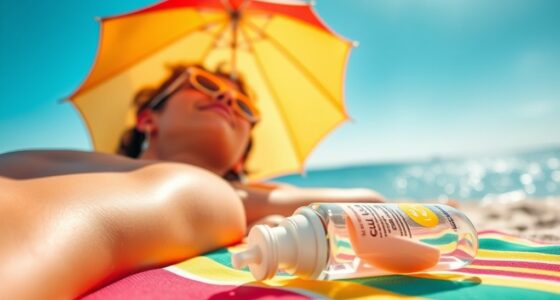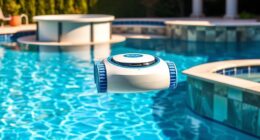Tanning does not reliably boost your vitamin D levels and actually poses serious health risks. While UVB rays help your skin produce vitamin D, tanning beds mainly emit UVA, which doesn’t promote vitamin D production and can increase skin damage and cancer risk. Darker skin also produces less vitamin D from UV exposure. For healthy vitamin D, it’s safer to get sunlight safely, eat vitamin D-rich foods, or use supplements—there’s more to contemplate if you keep looking into it.
Key Takeaways
- Tanning increases melanin, which absorbs UVB and reduces the skin’s ability to produce vitamin D.
- Tanning beds mostly emit UVA, which does not promote vitamin D synthesis; some may emit UVB but are unreliable.
- Higher skin pigmentation from tanning lowers vitamin D production despite darker skin appearance.
- Excessive tanning damages skin and increases cancer risk without effectively boosting vitamin D levels.
- Safe sun exposure and dietary sources are more effective and safer methods to maintain adequate vitamin D.
The Science Behind Vitamin D Synthesis and Sun Exposure

Understanding how your skin makes vitamin D begins with a simple but essential process: when UV-B rays from the sun hit your skin, they trigger a conversion of a compound called 7-dehydrocholesterol into previtamin D3. This precursor then isomerizes into vitamin D3. Only UV-B wavelengths (290–315 nm) can initiate this process; UV-A or visible light aren’t energetic enough. UV-B penetrates the epidermis and dermis, where 7-dehydrocholesterol resides. However, prolonged exposure doesn’t boost vitamin D levels because excess UV-B turns previtamin D3 and vitamin D3 into inactive photoproducts. Factors like latitude, season, time of day, skin pigmentation, age, and environmental barriers influence how efficiently your skin synthesizes vitamin D. Short, regular sun exposure during peak UV times helps maintain suitable levels without risking skin damage.
How Tanning Affects the Skin’s Ability to Produce Vitamin D

Tanning influences your skin’s ability to produce vitamin D by increasing melanin levels, which act as a natural sunscreen. Melanin absorbs UVB wavelengths needed for vitamin D synthesis, reducing the amount that reaches deeper skin layers. As a result, even if you spend time in the sun, a darker, tanned skin produces less vitamin D efficiently. Studies show that tanned individuals often have higher baseline vitamin D levels, but their skin’s response to additional UVB is blunted, meaning further exposure yields minimal benefits. Higher melanin content generally correlates with lower serum vitamin D levels, highlighting an inverse relationship. While tanning provides some protection against UV damage, it also limits your skin’s capacity to generate vitamin D, making it less effective despite increased pigmentation. Additionally, understanding crochet styles for locs can be a fun way to explore creative expression while protecting your hair from environmental damage. Moreover, UVB penetration can be affected by various environmental factors, further influencing vitamin D production. Furthermore, skin damage from UV exposure can lead to premature aging and increase the risk of skin cancer, emphasizing the importance of balancing sun exposure with protective measures.
The Role of UVB Light in Vitamin D Production
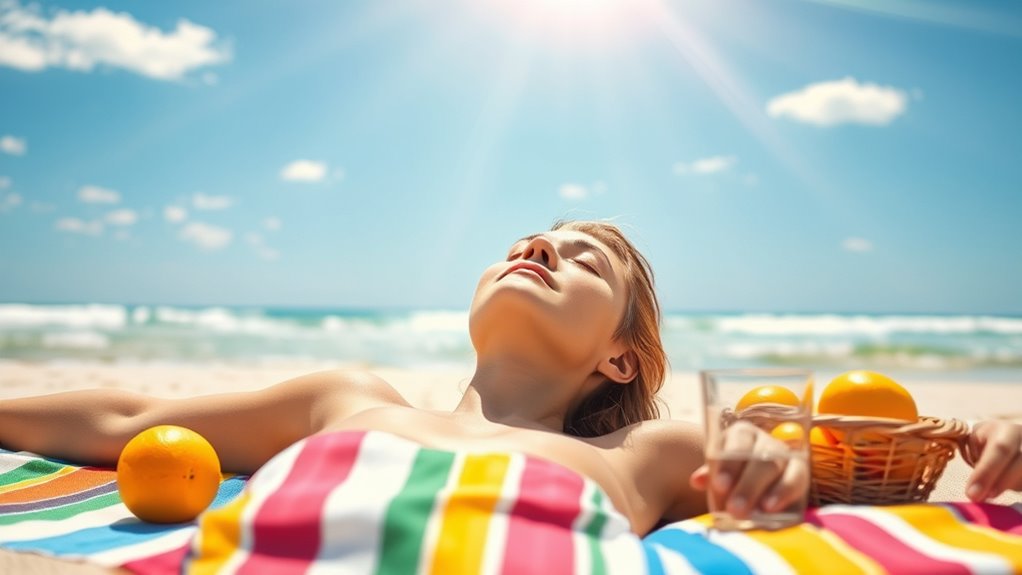
UVB light plays a direct role in the natural production of vitamin D in your skin. When UVB rays in the 290–315 nm range hit your skin, they activate 7-dehydrocholesterol, converting it into previtamin D3. This precursor then thermally isomerizes into vitamin D3. Both previtamin D3 and vitamin D3 can absorb more UVB, forming other biologically active compounds. Factors like season, time of day, atmosphere, skin pigmentation, and protective barriers influence this process. Sufficient UVB exposure is essential for efficient synthesis, but too much can cause skin damage. Once formed, vitamin D3 enters your bloodstream, gets processed in your liver, and then becomes active in your kidneys, supporting calcium regulation and overall health. This natural UVB-driven process is your body’s primary method of producing vitamin D. Notably, the efficiency of this process can vary significantly depending on individual skin pigmentation, which affects how much UVB is absorbed. Additionally, atmospheric conditions such as pollution or cloud cover can significantly impact the amount of UVB reaching your skin, thereby affecting vitamin D production. External factors like air pollution can also hinder UVB penetration, further reducing vitamin D synthesis.
Why Tanning Beds Aren’t a Reliable Source of Vitamin D
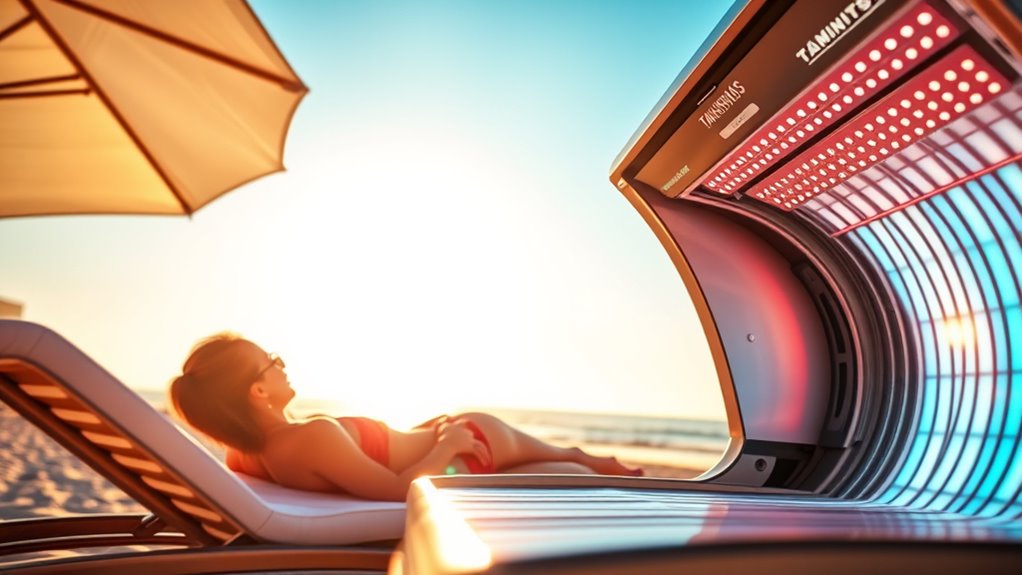
Most tanning beds primarily emit UVA light, which doesn’t promote vitamin D production. UVB light is essential for your skin to synthesize vitamin D, but typical tanning beds don’t emit enough UVB to make a difference. While some models do produce UVB, their emission levels vary widely, and there’s no standardization—meaning results are unpredictable. Even if a tanning bed increases your vitamin D temporarily, the effect is often short-lived and unreliable. Plus, the health risks associated with tanning beds, like skin cancer, far outweigh any potential benefit. Industry promotions often claim tanning beds can boost vitamin D, but scientific consensus and health organizations strongly advise against using them for this purpose. Relying on tanning beds isn’t a safe or effective way to maintain healthy vitamin D levels. Additionally, ethical hacking techniques demonstrate that relying on unverified sources for health benefits can be risky and unreliable. Furthermore, the efficacy of tanning beds for vitamin D synthesis is limited by the types of UV radiation they emit, making them an ineffective option for vitamin D intake. The UV spectrum emitted by most tanning beds is optimized for tanning rather than vitamin D production, reducing their usefulness for health benefits. It is important to recognize that scientific studies consistently show minimal and inconsistent vitamin D gains from tanning beds compared to safer alternatives like dietary sources or supplements.
Risks of Using Tanning for Vitamin D: More Harm Than Good
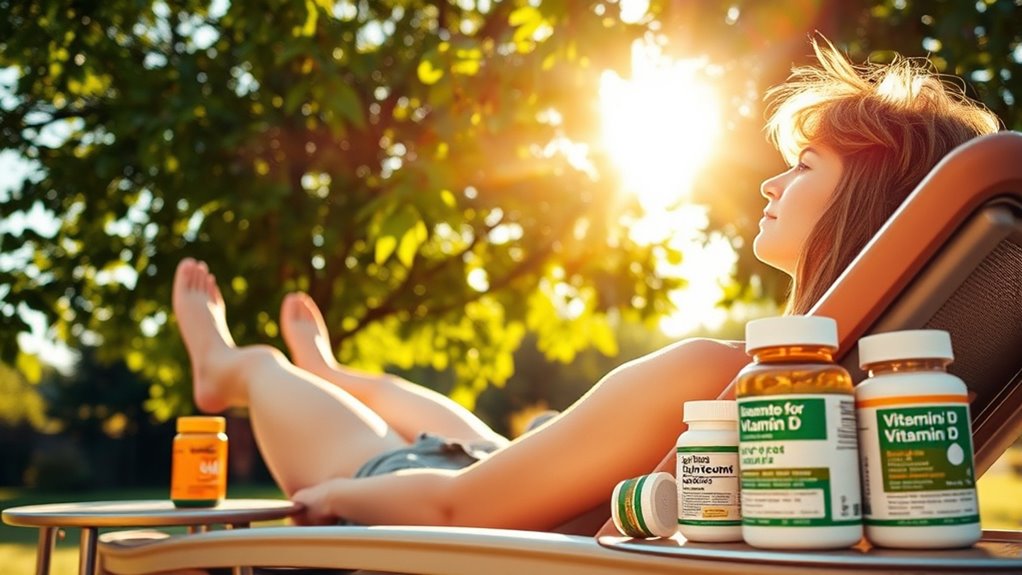
Despite popular beliefs, using tanning as a way to boost vitamin D can do more harm than good. Tanned skin doesn’t guarantee sufficient vitamin D levels; many individuals remain deficient despite regular sun exposure. Meanwhile, excessive tanning—whether outdoors or in tanning beds—increases your risk of skin cancer, including melanoma, which can be deadly. Tanning may also negatively affect vitamin D production by damaging your skin’s ability to synthesize it properly. UV radiation from tanning is classified as carcinogenic, with early tanning bed use nearly doubling your melanoma risk. Additionally, skin pigmentation influences vitamin D synthesis, making it less effective for darker skin types. Skin damage from UV exposure impairs the skin’s natural vitamin D synthesis process. Sun exposure alone is not always a reliable way to maintain healthy vitamin D levels, especially in regions with limited sunlight or for individuals with darker skin tones. Furthermore, sunscreen use can block UV rays that are necessary for vitamin D production, complicating the relationship between sun exposure and vitamin D levels. Emerging research also shows that excessive tanning can contribute to premature skin aging, which further increases health risks. It is also important to recognize that individual skin types affect how effectively your skin produces vitamin D in response to UV rays. Overall, the health risks far outweigh any potential benefit, and safer alternatives like diet and supplements are recommended for maintaining adequate vitamin D levels.
Factors Influencing Vitamin D Levels From Sun Exposure

Several factors influence how much vitamin D your body can produce from sun exposure. Your geographic location matters: closer to the equator, higher UVB intensity boosts vitamin D synthesis, while higher altitudes increase UVB levels, enhancing production. Seasonal changes also play a role; winter months at higher latitudes often provide insufficient UVB. Cloud cover and pollution block UVB rays, reducing vitamin D production, and indoor exposure through glass or plastics prevents it altogether. The time of day is essential—peak synthesis occurs between 10 a.m. and 3 p.m. when UVB radiation is strongest. Skin pigmentation affects this process; darker skin contains more melanin, requiring longer sun exposure for the same vitamin D levels. Clothing and sunscreens further limit UVB access, making sun exposure a complex, variable factor in vitamin D synthesis. Additionally, AI safety measures in monitoring AI outputs are crucial to ensure accurate health-related information.
Safer Alternatives to Tanning for Maintaining Adequate Vitamin D

To maintain adequate vitamin D levels without risking skin damage from tanning, you can rely on safer alternatives like dietary sources, supplements, and fortified foods. Fatty fish such as salmon, mackerel, and tuna are rich in vitamin D naturally. Eggs, beef liver, cheese, and fortified dairy or orange juice also contribute, but checking labels is essential. Vitamin D supplements, especially vitamin D3, offer a controlled, safe dose year-round, even in low-sun conditions. UVB lamps designed for vitamin D production can help when sunlight isn’t available, but they should be used cautiously under professional guidance. Fortified foods like milk, plant-based drinks, and cereals are convenient options. Additionally, recognizing angel number soulmates can inspire a positive outlook on health and well-being. Incorporating sun exposure guidelines can optimize vitamin D synthesis without overexposure risks. Recognizing the importance of natural sources for sustainable health can further support your vitamin D needs. Ensuring you understand electric bike conversion kits can be helpful if you’re considering alternative transportation that supports outdoor activity and sun exposure. Combining these strategies ensures you meet your vitamin D needs without the risks associated with tanning or sunburns.
Myth Busting: Tanning and Vitamin D in Popular Culture

Have you ever heard that tanning beds are a good way to boost your vitamin D levels? Many in popular culture believe this, but medical experts debunk the myth. Tanning beds mainly emit UVA light, which doesn’t help your body produce vitamin D. Some modern beds have UV-B lamps, but their use isn’t widespread, and health risks outweigh any benefits. Films, ads, and social media often promote tanning as a quick fix for vitamin D deficiency, despite scientific evidence showing it’s ineffective. These misconceptions contribute to dangerous behaviors, increasing risks of skin cancer and premature aging. UV light exposure is the primary factor affecting vitamin D synthesis, and relying on tanning beds is both ineffective and risky. Proper benefit from UV-B rays can only be achieved through safe sunlight exposure, as recommended by health experts. Education campaigns aim to dispel these myths, emphasizing safer ways to maintain healthy vitamin D levels. Remember, tanning beds are not a reliable or safe solution for vitamin D production. Moreover, understanding the dog names can be fun and may help you choose the perfect name if you have a new pet.
Recommendations From Health Experts on Achieving Healthy Vitamin D Levels
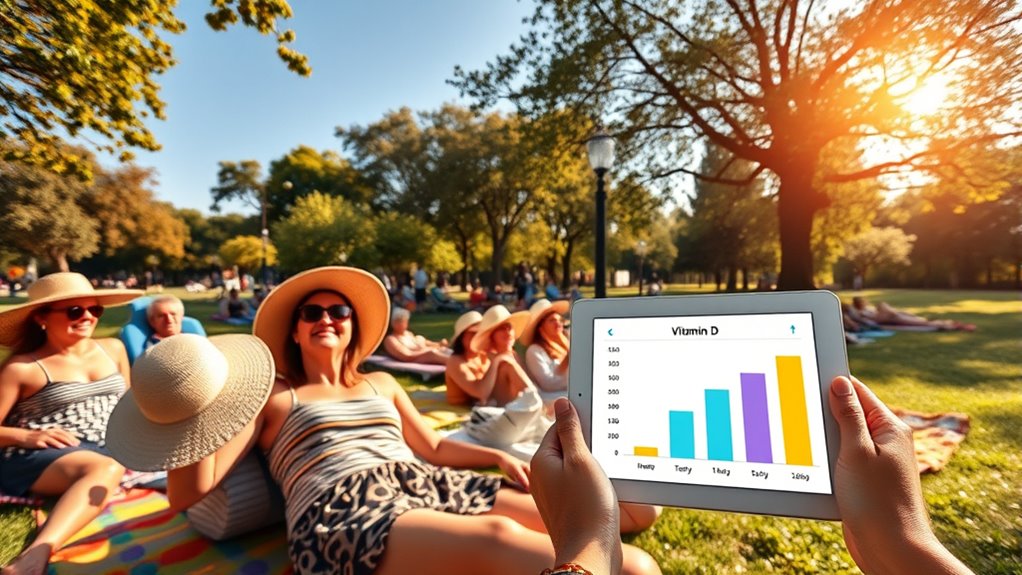
Achieving healthy vitamin D levels involves following evidence-based guidelines to guarantee you get enough without risking toxicity. Generally, blood levels of 20 ng/mL (50 nmol/L) or higher support bone and overall health, while levels below 12 ng/mL (30 nmol/L) indicate deficiency. The Endocrine Society recommends a minimum of 30 ng/mL, with 40-60 ng/mL considered ideal. Most adults naturally maintain levels between 20 and 40 ng/mL. To reach these levels, adults aged 1-70 should aim for 600 IU daily, and those over 70 need 800 IU. Supplementation should be personalized, and healthcare professionals should guide higher doses if you’re at risk of deficiency. Routine testing isn’t necessary unless you have specific health concerns or risk factors.
Frequently Asked Questions
Can Tanning Alone Prevent Vitamin D Deficiency?
Tanning alone usually can’t prevent vitamin D deficiency. While UVB exposure can boost your vitamin D levels, most tanning beds emit mainly UVA rays, which don’t help produce vitamin D. Factors like skin melanin, season, and latitude also limit natural synthesis, even with tanning. Relying solely on tanning exposes you to skin damage risks. Instead, consider safe sun exposure, supplements, or dietary sources to maintain healthy vitamin D levels effectively.
How Much Sun Exposure Is Needed for Adequate Vitamin D?
Imagine you’re at noon in summer, exposing your face, hands, and arms for about 10 minutes. That’s enough for most people to produce adequate vitamin D. Typically, you need around 8-10 minutes of direct sunlight during peak hours, depending on your skin type and location. Regular, moderate sun exposure helps maintain healthy vitamin D levels without overdoing it or risking skin damage.
Do Sunscreen and Tanning Reduce Vitamin D Synthesis?
You might wonder if sunscreen and tanning affect vitamin D synthesis. Research shows that daily sunscreen use doesn’t cause deficiency because even with SPF 15, enough UVB gets through for vitamin D production. Tanning, which increases melanin, can actually reduce UVB absorption. However, brief, non-burning sun exposure remains effective. To balance protection and vitamin D, follow recommended sun habits and consider dietary sources or supplements if needed.
Is Vitamin D Deficiency More Common in Darker-Skinned Individuals?
They say, “You are what you eat,” but with vitamin D, it’s also about how you get sunlight. Yes, vitamin D deficiency is more common in darker-skinned individuals because melanin blocks UVB rays needed for production. This means you need more sun exposure or supplements to maintain healthy levels. Factors like latitude, lifestyle, and clothing further influence your vitamin D status, making deficiency a real concern for darker skin tones.
Are There Safe, Natural Ways to Boost Vitamin D Levels?
You want to know if there are safe, natural ways to boost your vitamin D levels. You can get regular, sensible sun exposure on uncovered skin for about 10-30 minutes a few times a week, especially around midday. Eating foods rich in vitamin D like fatty fish, eggs, and fortified products also helps. Combining these methods guarantees you maintain healthy vitamin D levels without risking skin damage or health issues.
Conclusion
While it might seem like tanning could boost your vitamin D, the risks outweigh the benefits. Relying on sun or tanning beds can do more harm than good, and the truth is, safer options exist. By exploring healthy ways to get your vitamin D—like diet and supplements—you avoid playing with fire. Remember, sometimes you have to read between the lines; taking care of your health means making smarter choices rather than chasing quick fixes.


